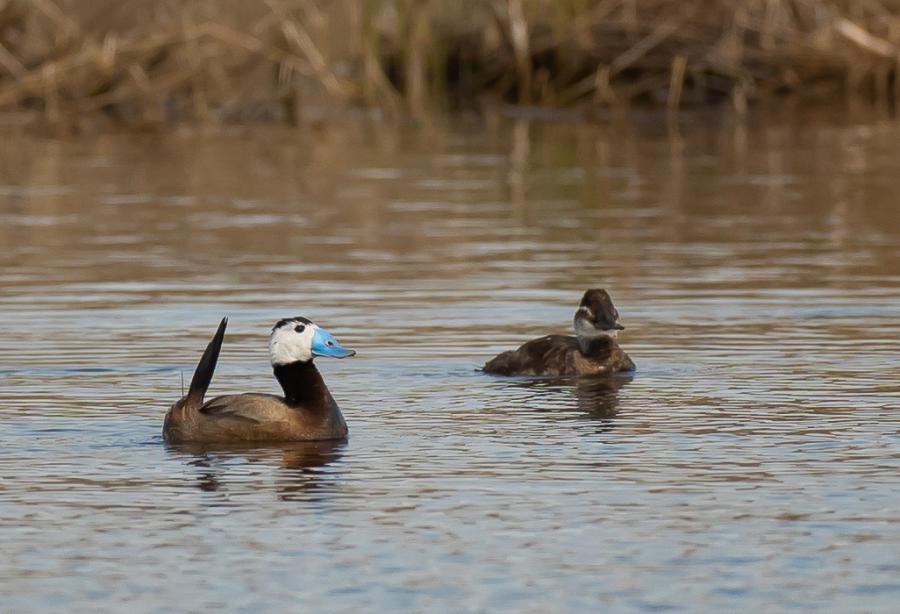
11 Days Xinjiang Birding Tour
The glaciers from these mountains provide the headwaters for most of Xinjiang's rivers. Situated far inland, Xinjiang experiences a typical arid temperate continental climate characterized by dry air, abundant sunshine, and an annual precipitation of only 150mm. This dry climate has transformed much of Xinjiang into desert landscape, accounting for two-thirds of China's total desert area. The majority of the region is sparsely populated, creating an ideal habitat for wildlife.
Thanks to its expansive landmass, diverse topography, and varying climate conditions, Xinjiang boasts rich biodiversity, The region is home to around 430 recorded bird species, featuring a range of birds from Europe and Central Asia that are not commonly found in other parts of China. This itinerary provides a classic route through Xinjiang, showcasing its unique and endemic bird species.
Day 1: Urumqi, Xinjiang, China
Your arrive in Urumuqi airport, we will then drive to your hotel in the city center for an overnight stay. If you arrive early, we will take a leisurely birdwatching trip at a nearby park.
Day 2: Urumqi to Shihezi via Baihu Lake and Nanshan
We will start with a brief visit to Baihu Lake before heading to Nanshan Mountain. Situated to the west of Urumqi, Baihu Lake serves as a vital breeding ground for various waterfowl such as Whiteheaded Duck, Ruddy Shelduck, Northern Shoveler, Gadwall, Red-crested Pochard, Common Pochard, Ferruginous Duck, Tufted Duck, Black-necked Grebe, Black-winged Stilt, Little Ringed Plover, Common Redshank, Common Tern, Turkestan Shrike, Bearded Tit, Pale Sand Martin, Common Starling, Isabelline Wheatear, etc.
Following our visit, we will drive approximately 60km south to Nanshan Mountain. The diverse ecosystems and significant elevation changes here create habitats for a wide range of bird species including Daurian Partridge, Booted Eagle, Himalayan Vulture, Golden Eagle, Eurasian Sparrowhawk, Upland Buzzard, Rock Pigeon, Stock Dove, European Roller, Eurasian Three-toed Woodpecker, Yellowhammer, Rufous-tailed Shrike, Eurasian Jackdaw, Coal Tit, Azure Tit, Crested Lark, Horned Lark, Northern House Martin, Barred Warbler, Lesser Whitethroat, Rosy Starling, Common Starling, Mistle Thrush, Blue-capped Redstart, Northern Wheatear, Isabelline Wheatear, Rufous-tailed Rock Thrush, Black-throated Accentor, Tawny Pipit, Tree Pipit, European Greenfinch, Common Linnet, Red-headed Bunting, etc.
After our explorations in the mountains, we will continue to Shihezi.
Day 3: Shihezi to Karamay
We will dedicate this day to searching for birds across different environments. In the morning, we will visit Mushroom Lake, located about 30 kilometers northwest of Shihezi.
Target at: Whooper Swan, Tufted Duck, Ferruginous Duck, Smew, Goosander, Lesser Sand Plover, Kentish Plover, Ruff, Caspian Gull, Gull-billed Tern, Caspian Tern, Black Tern, White-winged Black Tern, White-tailed Eagle, Pallas's Fish Eagle, Long-legged Buzzard, European Bee-eater, Eurasian Golden Oriole, Isabelline Shrike, Great Grey Shrike, Paddyfield Warbler, Great Reed Warbler, Barred Warbler, Black-throated Thrush, Common Chaffinch, European Greenfinch, etc.
After our birding session, we will begin the approximately 4-hour journey to Karamay. In Karamay, the surrounding Gobi deserts and Euphrates poplar forests will provide opportunities to spot: Eurasian Scops Owl, Pallid Scops Owl, Shikra, White-winged Woodpecker, European Bee-eater, Turkestan Shrike, Lesser Kestrel, Sykes's Warbler, Lesser Whitethroat, Common Whitethroat, Common Nightingale, Bluethroat, Common Rock Thrush, Common Redstart, Saxaul Sparrow, Isabelline Wheatear, Pied Wheatear, Desert Wheatear, Tree Pipit, etc.
Day 4: Karamay to Fuhai
This morning, we will have opportunities to search for species we may still need to spot before departing for Fuhai.
Targets: Demoiselle Crane, Steppe Eagle, Long-legged Buzzard, Greater Short-toed Lark, Eurasian Skylark, Crested Lark, Great Reed Warbler, Booted Warbler, Asian Desert Warbler, Common Chiffchaff, Northern Wheatear, Great Grey Shrike, European Goldfinch, Common Linnet, European Greenfinch, etc.
Upon reaching Fuhai, we will visit nearby villages and parks for birding. These areas are excellent for finding numerous forest birds, including European Roller, European Bee-eater, Red-backed Shrike, Turkestan Shrike, Isabelline Shrike, Bearded Tit, Blyth's Reed Warbler, Lesser Whitethroat, Mistle Thrush, Barred Warbler, Fieldfare, Spotted Flycatcher, etc.
Day 5: Fuhai to Altay
Today, most of our birdwatching will take place along the route. While traveling through forests and wetlands, we will look for species such as Caspian Gull, Common Goldeneye, Goosander, Daurian Partridge, Booted Eagle, Steppe Eagle, Long-legged Buzzard, Red-footed Falcon, Eurasian Scops Owl, Long-eared Owl, European Roller, Rock Dove, Stock Dove, Great Spotted Woodpecker, Lesser Spotted Woodpecker, Red-footed Falcon, Eurasian Hobby, Azure Tit, White-crowned Penduline Tit, Paddyfield Warbler, Great Reed Warbler, Savi's Warbler, Common Chiffchaff, Cetti's Warbler, Barred Warbler, Common Starling, Spotted Flycatcher, etc.
Day 6: Altay to Burqin
En route to Burqin, we will stop to search for Montagu's Harrier, Pallid Harrier, Western Marsh Harrier, Demoiselle Crane, Gull-billed Tern, Richard's Pipit, Common Reed Bunting, Paddyfield Warbler, Great Reed Warbler, Turkestan Shrike, Red-backed Shrike, etc.
Day 7: Burqin and Surroundings
We will spend the day visiting some of the most renowned birdwatching sites in Xinjiang, including Burqin Magic Forest, Burqin Magic Pond, and Chong Hu'er. These areas present different habitats and are great for spotting unique local birds.
In Burqin Magic Forest, our main targets will be Common Goldeneye, Goosander, Common Quail, Black Stork, Eurasian Scops Owl, Little Owl, White-backed Woodpecker, Lesser Spotted Woodpecker, Grey-headed Woodpecker, Black Woodpecker, Eurasian Hobby, Eurasian Golden Oriole, Red-backed Shrike, Turkestan Shrike, Lesser Grey Shrike, Azure Tit, Blyth's Reed Warbler, Lesser Whitethroat, Common Whitethroat, Common Chiffchaff, Fieldfare, Spotted Flycatcher, Common Chaffinch, etc.
Chong Hu'er Forest targets:
Ortolan Bunting, Pine Bunting, Yellowhammer, Rock Bunting, European Goldfinch, Common Linnet, Great Rosefinch, Common Rosefinch, Common Rock Thrush, Black Redstart, Spotted Flycatcher, Black Stork, Mistle Thrush, Fieldfare, etc
Day 8: Burqin to Beitun
We will use most of the day to search for any outstanding species we may still need in Burqin before continuing our journey to Beitun.
Day 9: Beitun to Qiakuertu
In Beitun, we will focus on two key locations: Ulungur River and Ulungur Lake. These areas, rich in reeds, are prime breeding grounds for various water birds, including Mute Swan, Ruddy Shelduck, Common Shelduck, Common Shelduck, Common Pochard, White-headed Duck, Slavonian Grebe, Black-necked Grebe, Black-winged Stilt, Pied Avocet, Eurasian Oystercatcher, Little Tern, White-winged Black Tern, Whiskered Tern, Common Whitethroat, Lesser Whitethroat, Barred Warbler, etc.
After birding, we will proceed to Qiakuertu.
Day 10: Qiakuertu to Urumqi
Today, we will return to Urumqi. The journey includes many desert habitats where we have good chances of spotting desert specialties such as Mongolian Ground Jay, Saker Falcon, Mongolian Finch, Saxaul Sparrow, Spanish Sparrow, Rufous-tailed Scrub Robin, Pallas's Sandgrouse, Chukar Partridge, etc. We will also have chances of seeing some exciting desert mammals like Mongolian Wild Ass, Przewalski's Horse, etc.
Day 11: Urumqi / Departure
After enjoying breakfast at the hotel, you will be transferred to the airport for your departure from Urumqi
Or to start the 3-day "Xinjiang Ground Jay Extension."


